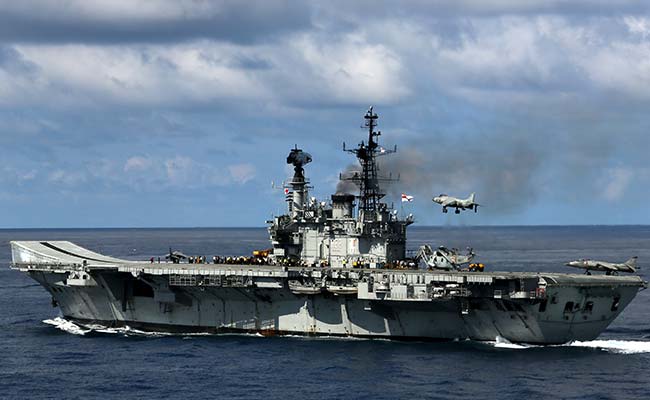20 countries will be participating in Singapore's first-ever International Maritime Review on 15 May 2017. 29 warships from all over the world will dock at Singapore's Changi Naval Base to celebrate the Republic of Singapore Navy's fiftieth anniversary. There will be three aircraft carriers (counting Japan's helicopter Destroyer, maybe four if China deploys Liaoning), cruiser, destroyers, frigates and other capital ships and support vessels. They will join 16 ships and submarines from the Singapore Navy for the review.
Participating Ships:
Republic of Singapore Navy Ships:
Formidable-class Frigates: RSS Formidable, RSS Supreme, RSS Stalwart
Archer-class Submarine: RSS Swordsman
Challenger-class submarine: RSS Conqueror
Victory-class Missile Corvettes: RSS Vigilance, RSS Valiant
Endurance-class Landing Ships, Tank: RSS Endurance, RSS Persistence
Independence-class Littoral Mission Vessels: RSS Independence, RSS Sovereignty
Fearless-class Patrol Vessels: RSS Fearless, RSS Daring
Bedok-class Mine Countermeasures Vessels: RSS Bedok, RSS Pungol, RSS Kallang
Singapore Police Coast Guard vessels:
Shark-class Coastal Patrol Craft: PH 58 Whitetip Shark, PH 56 Sandbar Shark
Thailand:
Aircraft Carrier: HTMS Chakri Naruebet
Naresuan-class Frigate: HTMS Taksin
Rattanakosin-class Corvette: HTMS Sukhothai
Indonesia (Tentara Nasional Indonesia-Angkatan Laut)
Sigma-class Corvette: KRI Sultan Hasanuddin
KCR60 Fast Attack Craft Missile: KRI Halasan
Brunei:
Darussalam-class Ocean Patrol Vessel: KDB Darussalam
Australia:
ANAZC-class Frigate: HMAS Ballarat
Bangladesh:
C13B-class Ocean Patrol Vessel: BNS Shadhinota
Canada:
Halifax-class Frigate: HMCS Ottawa
France:
Floreal-class Frigate: FS Prairial
India:
Shivalik-class Frigate: INS Sahyadri
Kamorta-class Corvette: INS Karmota
Japan:
Izumo-class Helicopter Destroyer: JS Izumo
Takanami-class Destroyer: JS Sazanami
Malaysia
Kasturi-class Corvette
Myanmar:
Kyan Sit Thar-class Frigate: UMS Sin Phyu Shin
New Zealand:
ANZAC-class Frigate: HMNZA Te Kaha
Tanker: HMNZS Endeavour
Pakistan:
Sword-class Frigate: PNS Zulfiquar
Philippine:
Gregorio del Pilar-class Frigate: BRP Ramon Alcaraz
Korea:
KDX-IIA Destroyer: ROKS Dae Jo Yeong,
Russia:
Slaca-class Cruiser: RFS Varyag
Sri Lanka:
Vikram-class Ocean Patrol Vessel: SLNS Sagara
Saar4-class Fast Attack Craft Missile: SLNS Nandimithra
United States:
Arleigh Burke-class Destroyer: USS Stethem
Independence-class Littoral Combat Ship: USS Coronado
Vietnam:
Gepard-class Frigate: Dinh Tien Hoang
China:
Jiang Kai II-class frigate: PLAN Huang Shan
CNA
 |
| The newly commissioned Littoral Mission Vessel, RSS Independence will be part of the maritime review. Photo from mindef.gov.sg |
Republic of Singapore Navy Ships:
Formidable-class Frigates: RSS Formidable, RSS Supreme, RSS Stalwart
Archer-class Submarine: RSS Swordsman
Challenger-class submarine: RSS Conqueror
Victory-class Missile Corvettes: RSS Vigilance, RSS Valiant
Endurance-class Landing Ships, Tank: RSS Endurance, RSS Persistence
Independence-class Littoral Mission Vessels: RSS Independence, RSS Sovereignty
Fearless-class Patrol Vessels: RSS Fearless, RSS Daring
Bedok-class Mine Countermeasures Vessels: RSS Bedok, RSS Pungol, RSS Kallang
Singapore Police Coast Guard vessels:
Shark-class Coastal Patrol Craft: PH 58 Whitetip Shark, PH 56 Sandbar Shark
Thailand:
Aircraft Carrier: HTMS Chakri Naruebet
Naresuan-class Frigate: HTMS Taksin
Rattanakosin-class Corvette: HTMS Sukhothai
Indonesia (Tentara Nasional Indonesia-Angkatan Laut)
Sigma-class Corvette: KRI Sultan Hasanuddin
KCR60 Fast Attack Craft Missile: KRI Halasan
Brunei:
Darussalam-class Ocean Patrol Vessel: KDB Darussalam
Australia:
ANAZC-class Frigate: HMAS Ballarat
Bangladesh:
C13B-class Ocean Patrol Vessel: BNS Shadhinota
Canada:
Halifax-class Frigate: HMCS Ottawa
France:
Floreal-class Frigate: FS Prairial
India:
Shivalik-class Frigate: INS Sahyadri
Kamorta-class Corvette: INS Karmota
Japan:
Izumo-class Helicopter Destroyer: JS Izumo
Takanami-class Destroyer: JS Sazanami
Malaysia
Kasturi-class Corvette
Myanmar:
Kyan Sit Thar-class Frigate: UMS Sin Phyu Shin
New Zealand:
ANZAC-class Frigate: HMNZA Te Kaha
Tanker: HMNZS Endeavour
Pakistan:
Sword-class Frigate: PNS Zulfiquar
Philippine:
Gregorio del Pilar-class Frigate: BRP Ramon Alcaraz
Korea:
KDX-IIA Destroyer: ROKS Dae Jo Yeong,
Russia:
Slaca-class Cruiser: RFS Varyag
Sri Lanka:
Vikram-class Ocean Patrol Vessel: SLNS Sagara
Saar4-class Fast Attack Craft Missile: SLNS Nandimithra
United States:
Arleigh Burke-class Destroyer: USS Stethem
Independence-class Littoral Combat Ship: USS Coronado
Vietnam:
Gepard-class Frigate: Dinh Tien Hoang
China:
Jiang Kai II-class frigate: PLAN Huang Shan
CNA


